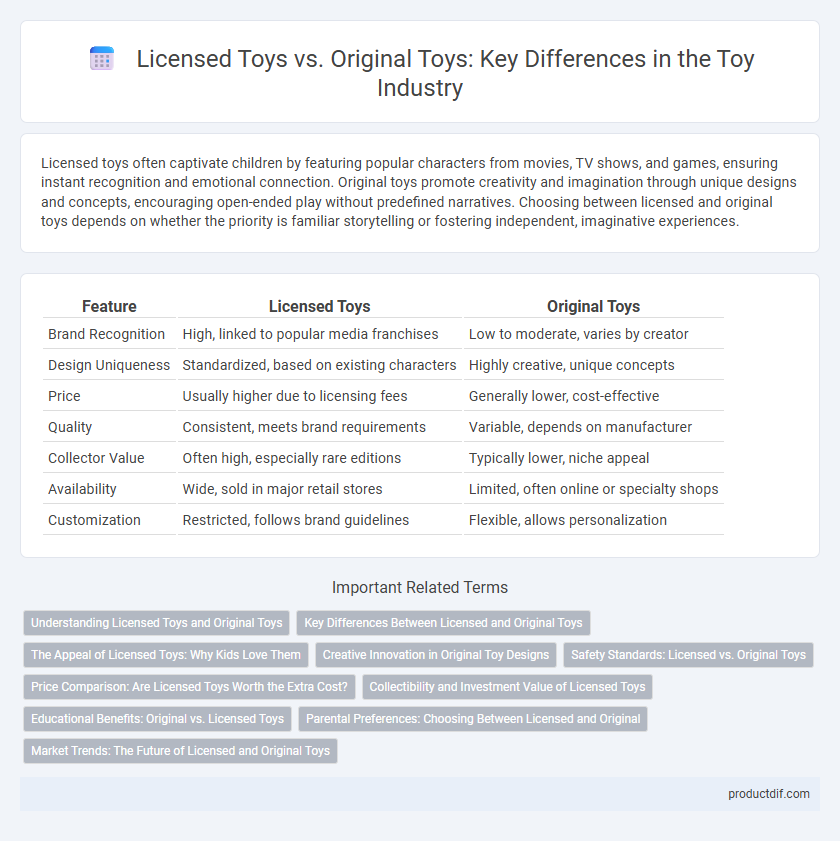Licensed toys often captivate children by featuring popular characters from movies, TV shows, and games, ensuring instant recognition and emotional connection. Original toys promote creativity and imagination through unique designs and concepts, encouraging open-ended play without predefined narratives. Choosing between licensed and original toys depends on whether the priority is familiar storytelling or fostering independent, imaginative experiences.
Table of Comparison
| Feature | Licensed Toys | Original Toys |
|---|---|---|
| Brand Recognition | High, linked to popular media franchises | Low to moderate, varies by creator |
| Design Uniqueness | Standardized, based on existing characters | Highly creative, unique concepts |
| Price | Usually higher due to licensing fees | Generally lower, cost-effective |
| Quality | Consistent, meets brand requirements | Variable, depends on manufacturer |
| Collector Value | Often high, especially rare editions | Typically lower, niche appeal |
| Availability | Wide, sold in major retail stores | Limited, often online or specialty shops |
| Customization | Restricted, follows brand guidelines | Flexible, allows personalization |
Understanding Licensed Toys and Original Toys
Licensed toys are products based on popular brands, characters, or franchises, offering familiar designs that attract fans and collectors. Original toys, created independently without brand affiliations, provide unique concepts and creative freedom for innovation in play experiences. Understanding the differences helps consumers choose between brand loyalty and novel creativity.
Key Differences Between Licensed and Original Toys
Licensed toys feature popular characters or brands from movies, TV shows, or franchises, ensuring instant recognition and emotional connection for children and collectors. Original toys are unique creations developed by manufacturers without external trademarks, focusing on innovation and distinctive designs. The key differences lie in brand association, production costs, and target market appeal, with licensed toys often commanding higher prices due to royalty fees.
The Appeal of Licensed Toys: Why Kids Love Them
Licensed toys captivate children by bringing their favorite movie, TV show, or video game characters to life, creating a strong emotional connection that original toys often lack. These toys offer a familiar story and recognizable branding that stimulate imaginative play and nostalgia, enhancing overall engagement. The combination of trusted franchises and high-quality production values makes licensed toys particularly appealing to both kids and parents.
Creative Innovation in Original Toy Designs
Original toy designs showcase unparalleled creative innovation by introducing novel concepts, unique characters, and inventive play features that distinguish them from licensed toys tied to existing franchises. These toys often push boundaries in materials, interactive technology, and educational value, fostering imaginative play and cognitive development. By prioritizing originality, toy makers contribute to industry evolution and offer consumers fresh, distinctive experiences beyond popular media licenses.
Safety Standards: Licensed vs. Original Toys
Licensed toys are subject to rigorous safety standards and certifications imposed by both licensors and regulatory bodies, ensuring compliance with material safety, choking hazard prevention, and non-toxic components. Original toys, while potentially innovative, may vary in meeting these stringent safety criteria depending on the manufacturer's adherence to industry regulations. Consumers often prefer licensed toys due to the guaranteed oversight and established quality controls that reduce risks related to durability and child safety.
Price Comparison: Are Licensed Toys Worth the Extra Cost?
Licensed toys often carry a higher price tag due to brand recognition and official approvals, providing authenticity and collectible value that appeals to fans. Original toys typically offer lower prices with similar play quality, appealing to budget-conscious consumers seeking creative freedom without the premium markup. Evaluating whether licensed toys are worth the extra cost depends on personal preference for brand loyalty versus cost-efficiency and innovative design.
Collectibility and Investment Value of Licensed Toys
Licensed toys often carry higher collectibility and investment value due to their association with popular franchises, limited production runs, and official endorsements. Collectors prioritize licensed toys because their authenticity and brand recognition tend to appreciate over time, making them sought-after assets in secondary markets. Original toys, while creative, generally lack the same market demand and historical significance, affecting their long-term investment potential.
Educational Benefits: Original vs. Licensed Toys
Original toys often offer more diverse educational benefits by encouraging creativity, problem-solving, and open-ended play, whereas licensed toys tend to focus on familiarity and brand recognition that can limit imaginative engagement. Educational advantages of original toys include fostering critical thinking and fine motor skills through versatile designs that adapt to various learning stages. Licensed toys might reinforce literacy and social skills related to popular characters but typically provide less scope for cognitive development beyond their established narratives.
Parental Preferences: Choosing Between Licensed and Original
Parents often favor licensed toys due to their recognizable characters from popular media, which can enhance a child's engagement and imaginative play. Original toys appeal to parents seeking unique, often educational, options that encourage creativity without reliance on existing franchises. The decision typically hinges on balancing brand familiarity with the desire for innovative, developmental experiences.
Market Trends: The Future of Licensed and Original Toys
Market trends indicate a steady growth in licensed toys driven by popular media franchises that boost consumer demand through recognizable characters and stories. Original toys are gaining momentum by appealing to niche markets seeking unique, innovative designs and promoting creativity. The future of the toy industry will balance the mass appeal of licensed products with the customizable, trend-forward advantages of original creations.
licensed toys vs original toys Infographic

 productdif.com
productdif.com